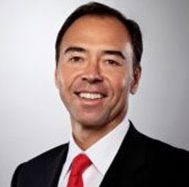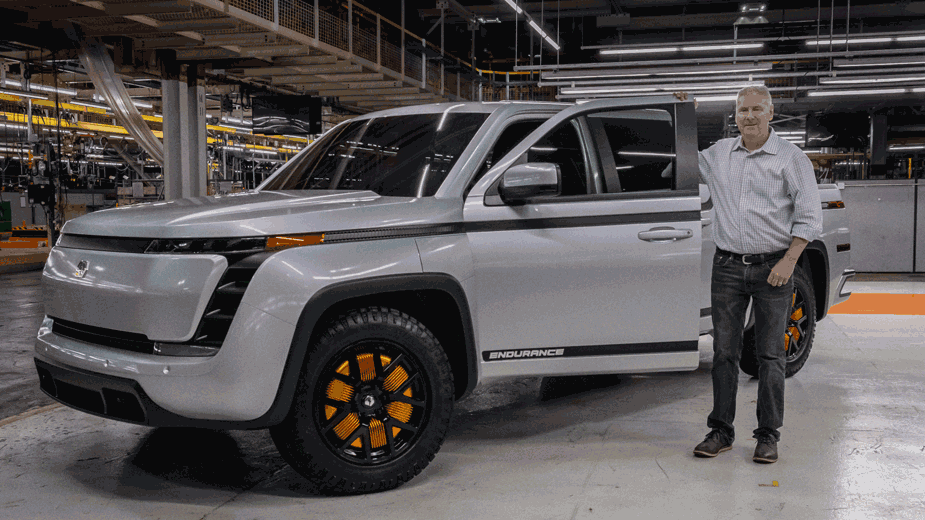Meet the Heavy Hitters Funding Lordstown Motors
LORDSTOWN, Ohio – Mark Walsh was a Wall Street dealmaker regarded by many as one of the sharpest real estate financiers in the country. That is, until his company, Lehman Brothers, collapsed in 2008 and took with it the rest of the U.S. economy.
Today, Walsh finds himself as a principal shareholder and director of DiamondPeak Holdings Corp., a special purpose acquisition company, or SPAC, that this month announced a merger with electric vehicle startup Lordstown Motors Corp.
Walsh, along with DiamondPeak CEO and New York real estate tycoon David Hamamoto, are among the heavy hitters ready to call the shots behind the fledgling Trumbull County automaker as it retools General Motors’ former Lordstown plant and prepares to launch its first vehicle, the Lordstown Endurance pickup, next summer.
“We started talking to SPACs about three months ago,” Lordstown Motors CEO Steve Burns told CNBC on Aug. 3. “You have to find one that’s a good fit and their CEO really melded with our vision and our team.”
DiamondPeak was formed in 2018 under Hamamoto’s leadership and went public in February 2019. According to filings with the Securities and Exchange Commission, the company was established to identify companies suited for mergers and acquisitions, especially ones “with a real estate component.”
The strategy made sense given DiamondPeak’s management team.
Walsh, who could not be reached for comment for this story, cut his teeth as a real estate attorney in Miami shortly after receiving his law degree from Fordham University School of Law in 1984. In 1988, he moved to the investment banking giant Lehman Brothers, where he earned profits that totaled in the “hundreds of millions” for the company through buying and selling loans on properties, many of which were in foreclosure, according to a New York Times profile published in 2009.
Walsh’s success didn’t go unnoticed, especially by Lehman’s chairman and CEO, Richard Fuld Jr. As Walsh rose through the ranks, he established close relationships with some of New York’s biggest real estate developers, coordinating, for example, Tishman Speyer’s 1997 purchase of the landmark Chrysler Building in Manhattan. By 2000, Walsh was selected to head a new private equity group at Lehman that was focused solely on real estate investments.
The market boomed. By 2004, Walsh became the director of Lehman’s Global Real Estate Group. To secure several high-profile real estate deals, Walsh deployed “bridge equity” financing and pumped Lehman money into the mix so its clients could beef up their offers. As long as the real estate market was hot, the firm collected hefty fees on all of these deals. According to reports, Walsh’s sector generated more than 20% of Lehman’s $4 billion profit at the height of the real estate boom in the mid-2000s.
But the strategy also left the company exposed in the event of a downturn. Among Walsh’s riskier ventures was lending $2 billion to SunCal, a speculative real estate company based in Irvine, Calif. By 2006, investors that initially bought in wanted out, forcing Walsh to purchase their stake and transfer those assets onto Lehman Brothers’ ledgers.

In another deal, Walsh spearheaded an effort to help Tishman Speyer acquire Archstone-Smith Trust, one of the largest apartment real estate investment trusts in the country, for $22 billion. Tishman Speyer put up just $250 million, while Lehman and Bank of America anted up $17.1 billion worth of debt and another $4.6 billion in bridge equity. That was in October 2007, just as the subprime market and credit crisis started to percolate. With no investment prospects, Lehman was left hanging – unable to sell off its bridge equity and stuck with a $2.2 billion stake in the project.
Ultimately, the combination of Lehman’s participation in both the high-risk subprime market and shaky commercial real estate ventures brought Lehman down like a house of cards. Unable to stanch the bleeding, Lehman filed for bankruptcy in September 2008, igniting a global economic crisis.
In an interview with Forbes in October 2008, former Lehman chief financial officer Erin McCallen appeared to shift some of the responsibility of Lehman’s demise onto Walsh. “The commercial real estate portfolio was really the albatross of the firm,” she said. According to reports, Lehman ended up with $29 billion in bad commercial mortgage debt on its books by the second quarter of 2008.
Nevertheless, Lehman executives still stood to cash in big.
According to documents obtained by The Los Angeles Times in 2012, Walsh was entitled to a pay package of $17.5 million in 2007, a year before the bankruptcy. In a three-year period, the real estate executive hauled in $70 million, according to the report.
Others see Walsh as a talented, intelligent and creative executive who generously supports initiatives in education and civic improvement.
“He’ll be back,” German developer Aby Rosen said in the New York Times profile. “He picked up the phone and people listen. Nobody can take that away from him.”
Two years later, he was back. In 2010, Walsh co-founded and now serves as managing director of Silverpeak, which bills itself as an “alternate investment management firm” that specializes in real estate, energy and credit markets. According to SEC filings, Silverpeak is an investor in DiamondPeak Sponsor LLC, along with Hamamoto. Both Hamamoto and Walsh also hold private shares in DiamondPeak.
Hamamoto is also renowned in high-stakes real estate circles. In 2015, CNN Business ranked the founder of NorthStar Realty Finance Corp. ninth on its list of top-earning CEOs. That year, the executive earned more than $60 million in cash and stock options. In 2016, Colony Capital merged with NorthStar Realty and NorthStar Asset Management – a deal that Donald Trump confidant and Colony CEO Thomas Barrack thought would create a real estate investment trust valued at $9 billion.

But the venture started to tank shortly after the deal closed. Hamamoto left the new company, Colony NorthStar, in November 2017. The following month, SEC filings showed Hamamoto sold off large chunks of his shares at prices as high as $12 per unit, making $27 million. As of Aug. 6, Colony was trading at $1.98 per share.
So, why does a SPAC such as DiamondPeak pivot from its expertise in real estate and dive into the electric-vehicle market?
During a conference call with analysts Aug. 3, Hamamoto said that his firm has evaluated “hundreds of companies” since going public last year. “In this search, Lordstown Motors stood out as a differentiated, high-growth electric vehicle company.”
Hamamoto says that Lordstown Motors’ business plan and product is “transformational” in that it tackles two of the most valuable areas in the automotive sector: electric vehicles and light-duty trucks. The Lordstown Endurance pickup is expected to be the first all-electric, light-duty truck on the market when deliveries begin next summer.
Lordstown Motors was created in the wake of General Motors’ decision in 2018 to idle its Lordstown assembly complex, which manufactured the Chevrolet Cruze. In March 2019, the final Cruze moved down the line and the company officially closed the plant in October of that year.
In May of 2019, President Trump erroneously announced that GM had sold the plant to Workhorse Group, a Cincinnati-based company that produces all-electric vans and delivery vehicles. Instead, a group – now Lordstown Motors – formed by former Workhorse CEO Steve Burns made a bid to buy the plant, with Workhorse chipping in as a 10% equity investor.
GM sold the plant to Lordstown Motors in November 2019, after the Detroit automaker tendered a $40 million mortgage loan to the startup that was used to purchase and begin retooling the factory.
The merger agreement boosts Lordstown Motors’ net value to $1.6 billion as a wholly owned subsidiary of DiamondPeak. The deal calls for $675 million in new investment to Lordstown, $500 million of which is backed by outside investors. Among these investors is GM, which has pledged $75 million. That investment includes in-kind contributions already made in the form of the $40 million mortgage.
Lordstown Motors said last year it was looking to raise about $450 million to kick-start manufacturing the new pickup. However, Burns says securing private financing proved challenging because of the coronavirus epidemic.
Instead, Lordstown Motors opted for a SPAC so it could propel the company toward a public offering. Once the merger is completed – expected in the fourth quarter – Lordstown Motors will be listed on Nasdaq under the trading symbol “RIDE.”
Burns told CNBC that the company interviewed “four or five” SPACs before settling on DiamondPeak. “I did find out that all SPACs are not created equal, and you’ve got to find one that’s a good fit.”
A SPAC, also known as a “blank check” company, can be beneficial for early stage firms since it eliminates much of the initial legwork and marketing efforts usually required with a traditional IPO, says Jonathan Lapine, a principal at W3 Wealth Management in Warren.
Much of that work was already completed when the SPAC completed its own IPO, in this case, DiamondPeak’s offering in 2019. “It’s about speed and simplicity,” he notes. “There’ve been a few SPACs in the electric-vehicle space over the last few months.”
In June, EV automaker Nikola Corp. announced it had secured financing through a reverse merger with VectoIQ, a SPAC. Nikola competes in the heavy-duty truck market but plans to build an all electric pickup, the Badger.
Another heavy truck automaker, Hyliion, announced in June it would go public through a SPAC. Meanwhile, the EV truck market is getting more crowded. Electric auto giant Tesla has announced its plans to deliver its light-duty truck, the Cyber, to consumers sometime between late 2021 and early 2022. GM, Ford Motor Co., Rivian and Volkswagen all have announced plans to produce new electric trucks, SUVs and vans.
The first to market with a specific all-electrical light-duty truck could come out as the big winner. It is among the reasons Lordstown Motors opted to merge with DiamondPeak, says Ivan Drury, an auto analyst for Edmunds.
“No one wants to be the one who regrets it,” he says. “The amount of missed opportunity is too great.”
Automakers such as Ford, GM and Tesla have some protection because of a diversified product portfolio. But startups face a challenge, Drury notes. Within 10 years, he projects some of these automakers will no longer exist.
One mistake, one misstep in the launch process, for example, could be costly to an early stage EV manufacturer, Drury noted. “Customers, media, investors – everyone is looking for that success story,” he says. “But, only a few of these companies are going to come away being able to say they succeeded.”
Burns says many of those potential competitors such as Nikola target the mid-size electric truck market, while Lordstown Motors has carved out a presence in the full-size pickup segment. Others such as GM and Ford, which are in the development stages of building a full-size electric pickup, also have to compete with their own conventional fuel models, he says.
Burns, who addressed analysts on the same conference call as DiamondPeak’s Hamamoto Aug. 3, says the company has registered 27,000 preorders for the Endurance, accounting for $1.4 billion in sales revenue. He says the DiamondPeak merger allows the company to break even or even turn a small profit by 2022, the first full year of production. By 2024, the CEO says he expects to manufacture 100,000 units and achieve a 10% profit.
Still, Lordstown Motors’ prospects ride on a single factor, Burns emphasizes. “We have to make a great truck,” he told CNBC. “If we make a great truck and we have happy customers, no matter what our financing facility is, we’ll be successful.”
It was enough to convince DiamondPeak and its six-member management team to throw its weight behind Lordstown Motors, especially with GM as an anchor investor. In addition to Hamamoto and Walsh, two directors are former executives of NorthStar; one is a veteran of Lehman and its successor, Barclays, while another held an executive position at Silverpeak. “The right team, combined with deep financial resources provided by this transaction, position Lordstown to thrive in a rapidly evolving industry,” Hamamoto says.
Pictured: Lordstown Motors CEO Steve Burns says he expects the startup automaker to have 10% profit by 2024.
Copyright 2024 The Business Journal, Youngstown, Ohio.



